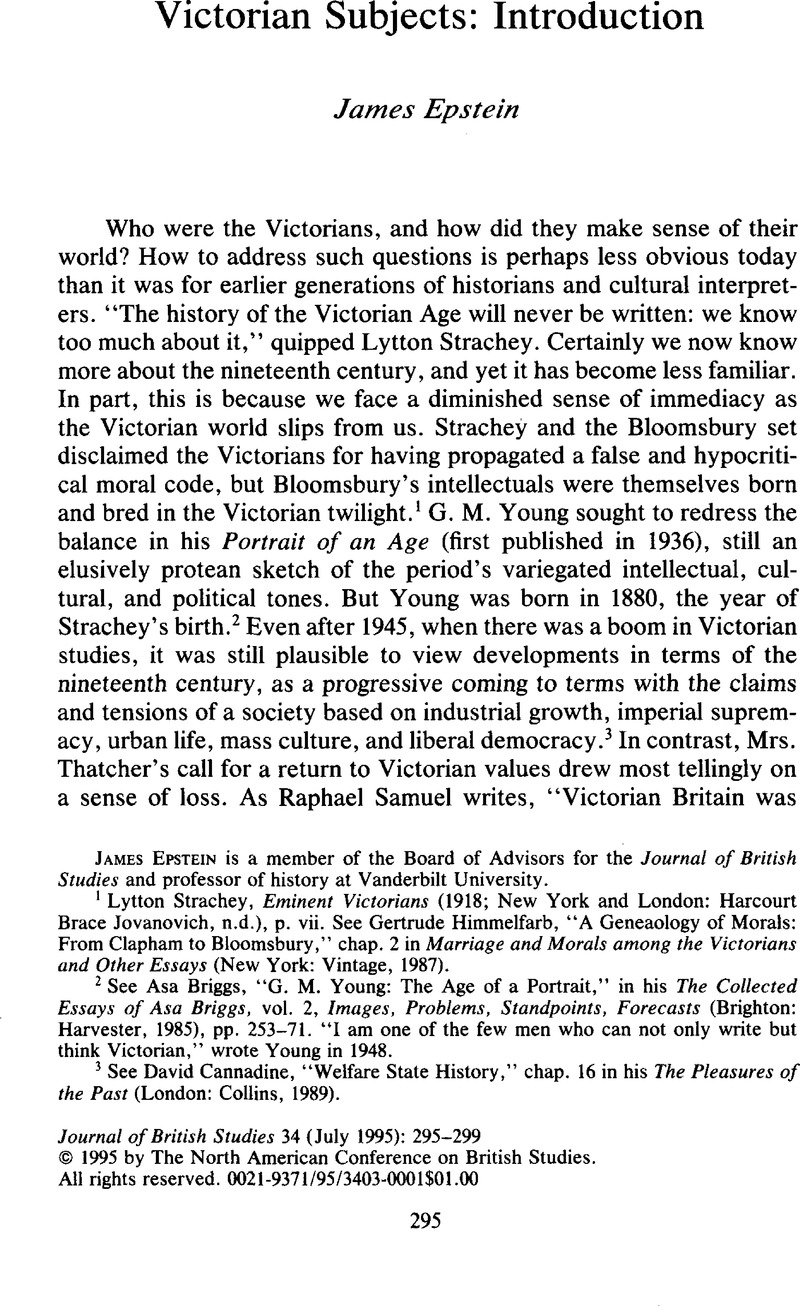No CrossRef data available.
Article contents
Victorian Subjects: Introduction
Published online by Cambridge University Press: 10 January 2014
Abstract

- Type
- Introduction
- Information
- Copyright
- Copyright © North American Conference of British Studies 1995
References
1 Strachey, Lytton, Eminent Victorians (1918; New York and London: Harcourt Brace Jovanovich, n.d.), p. viiGoogle Scholar. See Himmelfarb, Gertrude, “A Geneaology of Morals: From Clapham to Bloomsbury,” chap. 2 in Marriage and Morals among the Victorians and Other Essays (New York: Vintage, 1987)Google Scholar.
2 See Briggs, Asa, “G. M. Young: The Age of a Portrait,” in his The Collected Essays of Asa Briggs, vol. 2, Images, Problems, Standpoints, Forecasts (Brighton: Harvester, 1985), pp. 253–71Google Scholar. “I am one of the few men who can not only write but think Victorian,” wrote Young in 1948.
3 See Cannadine, David, “Welfare State History,” chap. 16 in his The Pleasures of the Past (London: Collins, 1989)Google Scholar.
4 Samuel, Raphael, “Mrs. Thatcher's Return to Victorian Values,” in Victorian Values, ed. Smout, T. C. (Oxford: Oxford University Press, 1992), p. 18Google Scholar.
5 See Price, Richard, “Historiography, Narrative, and the Nineteenth Century,” Journal of British Studies (in press)Google Scholar; also Harris, José, Private Lives, Public Spirit: A Social History of Britain, 1870–1914 (Oxford: Oxford University Press, 1993)Google Scholar.
6 Compare Houghton, Walter E., The Victorian Frame of Mind, 1830–1870 (1957; New Haven, Conn., and London: Yale University Press, 1975), p. xiiiGoogle Scholar. Houghton argues that there was a “common culture” for which the term “Victorianism” is appropriate, but he restricts his classic study to “artist-thinkers.” Himmelfarb writes: “Mid-Victorian England was more moral, more proper, more law-abiding than any other society in recent history” (p. 21).
7 Thus, e.g., the “bourgeois style” in sexuality and love may not easily fit stereostyles of Victorian prudery and passionless marriages. See Gay, Peter, The Bourgeois Experience, vol. 1, Education of the Senses (Oxford: Oxford University Press, 1984)Google Scholar; Barret-Ducrocq, Françoise, Love in the Time of Victoria, trans. Howe, John (Harmondsworth: Penguin, 1992)Google Scholar, for sexual relations among the laboring poor; Mason, Michael, The Making of Victorian Sexuality (Oxford: Oxford University Press, 1994)CrossRefGoogle Scholar. For the sexual crisis of the late nineteenth century, see Showalter, Elaine, Sexual Anarchy: Gender and Culture at the Fin de Siècle (New York: Penguin, 1990)Google Scholar.
8 Cain, P. J. and Hopkins, A. G., British Imperialism: Innovation and Expansion, 1688–1914 (London and New York: Longman, 1993), pp. 31–35Google Scholar, and chap. 1 more generally.
9 Ruskin, John, Sesame and Lilies (1865; London and Toronto: J. M. Dent, 1907), p. 69Google Scholar. See Davidoff, Leonore and Hall, Catherine, Family Fortunes: Men and Women of the English Middle Class (Chicago: University of Chicago Press, 1987)Google Scholar, for a comprehensive and nuanced analysis of the formation of early Victorian gender ideology and practice. For doubts about the usefulness of the concept of separate spheres, see Vickery, Amanda, “Golden Age to Separate Spheres? A Review of the Categories and Chronology of English Women's History,” Historical Journal 36 (1993): 383–414CrossRefGoogle Scholar.
10 Hilton, Boyd, The Age of Atonement: The Influence of Evangelicalism on Social and Economic Thought, 1795–1865 (Oxford: Oxford University Press, 1988)Google Scholar.
11 See Colley, Linda, “Britishness and Otherness: An Argument,” Journal of British Studies 31 (1992): 309–29CrossRefGoogle Scholar.
12 Compare Rubinstein, W. D., “British Radicalism and the ‘Dark Side’ of Populism,” in his Elites and the Wealthy in Modern British History: Essays in Social and Economic History (Brighton: Harvester, 1987), pp. 339–73Google Scholar.


